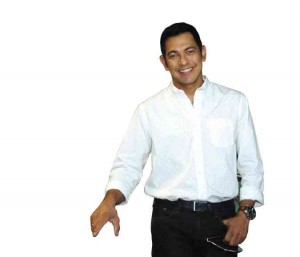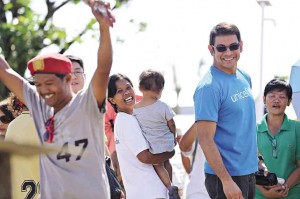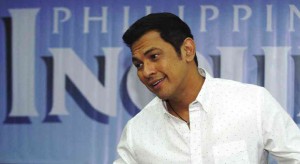Gary V sees it clearly now: I was meant to stay
The stage has become Gary Valenciano’s second home, having been a music artist for 30 years. But, looking back, he said his most indelible experiences didn’t all take place under the blinding spotlights or amid thunderous applause.
As it happened, many wonderful moments came when Gary least expected them. Once, a landslide in Sagada made him stay longer than expected and hold an impromptu show for kids in a small classroom. Another time, in a span of a few hours, he went from playing golf with his buddies to singing for an audience of one—former President Corazon C. Aquino—in an empty ballroom.
“Some of the most gratifying events in my life neither took place onstage, nor were staged. They just… came about,” Gary, who’s turning 50 and celebrating his third decade in the biz this year, said in a recent interview at the Inquirer head office in Makati City.
In 1998, Gary became the United Nations Children’s Fund (Unicef) Philippines’ first national ambassador. As such, he embarked on humanitarian missions around the country, helping needy children or calamity victims.
It was on one of those trips that Gary realized: One person thanking him for a single song could lift his spirit sometimes more than hearing his name chanted by thousands in an arena.
“When someone in some far-flung place asks if he could… just hug you, the feeling is incomparable, unquantifiable,” he said. So much so that, he revealed, he was planning to compile such stories in a book.
Article continues after this advertisement“I’m blessed to have the best of both worlds,” said the singer/composer, who’s holding a two-night concert at the Smart Araneta Coliseum titled “Arise 3.0” on April 11 and 12.
Article continues after this advertisementGary enthusiastically recounted many more instances that would surely go into the compilation, and not just in words: He stood from his seat to reenact scenes; he gestured wildly, danced in his seat and, every so often, drummed the table with his fingers, beat-boxed, or broke into a song.
Why is the concert titled “Arise 3.0”?
My first major solo concert in 1984 at the Big Dome was called “Gary V: A-Live.” For this 30th anniversary show, we’re having something similar. In a way, it shows that I’ve come full circle.
What can the fans expect?
I’m working with my son Paolo, who’s directing; he knows me and my music very well. We have a cool lineup of guests—Rico Blanco, Sam Concepcion, Sarah Geronimo… My kids Kiana and Gabriel will be there as well.
Is there a particular theme?
It will simply be a night of my music, but the way it will be presented will bring back memories. The latter part of the concert is where I’ll crank it up. The task is to pack all the songs in about two hours. There will be more singing than talking. The songs will speak for themselves.
Will there be more original songs than covers?
I’m thankful that, after 30 years in the biz, I can definitely come up with a concert in which most of the songs are mine.
Will you perform a different set list on the second night?
The only difference is Sarah will be a guest on the second night. Fans have been requesting for us to dance. We rarely do upbeat numbers together, so we’re both excited.
You’ve said that, dance-wise, you go for precision more than explosiveness.
I can’t get away from “explosive” moves— I’m going to move as much as I can, but I don’t want that to be the focus. We can also do more precise, smaller movements.
What is it like working with Paolo?
Paolo is very concerned about how things impact people. And he brings out the artistry of the person he’s working with.
Do your kids have more than what you had at their age?
Oh yes, because the opportunities are right there already for them. I started directing my own concerts only 10 years ago. Paolo has done shows for Sam Concepcion, Sponge Cola, and a fundraiser featuring Lea Salonga and Martin Nievera. In terms of directing, Paolo has surpassed what I’ve done.
Gabriel’s “super selfie” videos have, like, two million views, and were featured in “Good Morning America.” We were in Disneyland once and someone said, ‘Dude, you’re the ‘super selfie’ guy!’”
Kiana is into fashion design, but she can also sing. Her voice is unique, husky, airy— suited for pop-R&B. She and Paolo will be coming up with their own albums soon.
Was there pressure on the kids to go into show biz?
They went through a lot… I told them, “If I don’t require you to sing, move, talk, dress or look like me, there’s a reason. You have your own set of wings. I’ll fly with you—but I can’t fly for you. You go in the direction where you feel you’re going to shine the most.”
How much of you now is a performer still, and how much is a mentor?
I’ve done things I never thought I’d achieve… I’m leaning more toward mentor mode now. We manage and mentor this all-girl singing group called AKA Jam. They recently did a fundraiser in the United States, where they performed just two numbers but the crowd rose to its feet.
Who were your own mentors?
When I was in the Kundirana (a singing group in La Salle Greenhills), the teachers instilled in us a simple but compelling truth about being an entertainer: It’s bringing joy to others through music.
When did you realize that being a performer was what you wanted?

FAMOUS dad told his talented kids: “You have your own set of wings. I’ll fly with you—but I can’t fly for you.” RODEL ROTONI
Early on, it was all about the girls’ screams. It was only when I performed at Immaculate Conception Academy 30 years ago that I realized there was more to it. I was asked to do a song called “Magkaisa,” originally performed by Eugene Villaluz in the 1981 Metropop.
The song fit the evening very well. I was [rewarded] not with screams, but with, “Ang galing! You sang so well!” That was something I had been missing out on. I began thinking that there were things I could do with music to create impact, regardless of where I went or who were in front of me. I started choosing my songs more carefully.
Do you consider that a turning point?
It was more of a starting point for me… Actually, I’m putting together materials for a book on 30 events in my career and 50 events in my life that molded me into the person that I am today. That show is one of those.
So what was the turning point?
It would have to be my first big solo concert. [My wife] Angeli was pregnant at the time and it was a big scandal. I was 19, barely a year in the industry. Speculations first came out in a tabloid with the headline, “Unwed father—who will it be?” It was accompanied by photos of Martin Nievera, Raymond Lauchengco and myself. I remember being on the way to a gig when a newsboy knocked on the car window and asked if it was me!
We held a press con prior to the concert. My manager Sandra Chavez asked if I was going to talk about that. If I was asked, I said, I would just say it. I figured, when the child was older, he would ask why I wanted to hide him. I didn’t want to deal with that. True enough, the first question was about that piece of news. Some of the media people said this could spell the end of my career. “You’re young, and you’re going to be a father,” they said.
What went through your mind?
I decided to use the concert as a gauge. If people came then I still had a career. If no one showed up, I’d just head back to the United States.
Minutes before curtain call, my sister Gina entered the dressing room, in tears. “What,” I said, “no one turned up?” She broke down and said, “The show is sold-out!”
I entered from the bleachers. It was very dark, but I could hear loud screaming. Then the music started. I saw the dancers on the stage; I looked around and there were people everywhere. I had goosebumps. I knew then I was meant to stay.
What other memorable experiences will be in the book?
Back in 2001, my two friends and I were playing golf at Hacienda Luisita when a lady told me that the former President Corazon Aquino was at the yet-to-open Aquino Center Museum, and wanted to meet me. So for around two and a half hours, Tita Cory—without bodyguards or secretary—gave us a tour around the museum. We wanted badly to take a photo with her, but phones back then didn’t have cameras!
After the tour, she led us to an empty ballroom. She told me to check it out, see if I could imagine doing a show there. I clapped my hands as some sort of sound check. Tita Cory was watching me intently… and then she asked me to sing. I got up onstage and did “I’ll Be There.” It was just me, performing for the former President of the Philippines… When we got back to the car I thought, “What just happened? Was that real?”
What about your activities with Unicef?
For sure a lot of that is going into the book! We once visited a school inSagada. The kids had prepared a program but couldn’t perform because it rained. We couldn’t leave the school because of a landslide; we had to wait till the roads were cleared. So we gathered in a small classroom, set up the sound system inside and I did a show! The children stayed by my side as I sang and danced. It was unrehearsed… It was incredible!
You went to visit “Yolanda” survivors in Tacloban early this year.
Yes, I was there in January. I wanted to see what structures were still useful. But everything was damaged. I walked around the mass graves; there were signs indicating whose relatives

In January, he visited Supertyphoon “Yolanda” survivors in Tacloban. “My role is to bring them hope,” he says.
were buried there. People no longer got shocked when a new body arrived.
At a dinner for Unicef people, I met a German guy who had witnessed disasters in Syria, Pakistan and China. He said he had never seen people like the Filipinos, so demonstrative in their gratefulness. He said it was as if the people were apologetic that they couldn’t invite the foreign visitors to their homes.
The German guy said there was something about the Filipinos’ smile that exuded hope. He congratulated me. I said, “What for?” To which he replied, “Just for being a Filipino.” It was so sincere, I was really moved.
These stories keep getting better!
Another place we visited, a few years back, was NPA-infested. I can’t mention where exactly, without Unicef’s permission. At the center of the boulders was this oasis—a clearing where a school stood. Many of the children’s parents were rebels. The school was holding a graduation program. We were told that the parents were watching, using binoculars, from the surrounding hills.
How did your relationship with Unicef come about?
I was doing concerts for them as early as 1991. In 1998, I was asked to participate in their work, as an ambassador.
So children’s concerns have become a personal advocacy for you?
Oh, yes. I’m turning 50 but I can still travel to different places. I might as well maximize my time, now that I am, to a certain extent, still influential enough to help.
Did you ever expect to be doing all these things?
I did not expect it the way it’s happening now, but I’ve always had these ideas… I’m still being molded in this aspect, which is good.
You realize that you can’t solve the problems of all the children in the world.
We don’t try to solve their problems—we give them “tools” with which to do it themselves. When we go to a community, we tell the people that we are helping their leaders start beneficial programs… Later, we return to see the progress.
I’m not a problem-solver, but if I could play the role of giving hope that these problems can be solved, then I’d like to do that.
When I step onstage and speak to the survivors, I tell them what I personally go through. I tell them that storms take different forms. It could be a conflict with parents or a loved one, health issues. I share with them my struggles with diabetes.
How does diabetes affect you as a performer?
As an artist, if I wasn’t prepared or if my sugar level was low, I wouldn’t last onstage, or I might forget the lyrics. I could break into a cold sweat… or not sweat at all.
When my sugar level is high, I become temperamental, and even the little problems on stage make me grumpy. That’s just how it is. But if you put your mind to it you might get yourself under control, but not 100 percent.
Does it force you to hold back on your performances?
No, because performing gives me joy. There’s a few times, before a show, when I feel out of sorts. But when the music starts, it’s like a switch inside me flips on!
What’s next for you?
This I say boldly—I’d like to act a little more. I also want to explore other genres of music that people never knew I liked.
